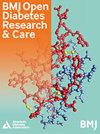青少年糖尿病诊断时的儿童机会指数和临床特征:1 型糖尿病与 2 型糖尿病
IF 3.7
2区 医学
Q2 ENDOCRINOLOGY & METABOLISM
引用次数: 0
摘要
导言:在患有 1 型糖尿病(T1D)的青少年中,血糖控制不佳的纵向原因与邻里的不利社会经济条件有关。儿童机会指数(COI)包括教育、健康、环境、社会和经济因素,与青少年肥胖有关,但尚未对新发 T1D 或 2 型糖尿病(T2D)青少年进行评估。我们假设,较低的 COI 与糖尿病诊断时的不良临床结果有关,并且由于风险因素和病理生理学的不同,新发 T2D 患者的 COI 会低于 T1D 患者。研究设计和方法 对一家大型学术儿科医院收治的新发糖尿病青少年进行回顾性队列研究。使用t检验和Χ2检验比较不同糖尿病类型的COI。采用多变量线性回归分析和逻辑回归分析评估COI与临床特征之间的关系,按糖尿病类型进行分层,并对年龄和性别进行调整。结果 按糖尿病类型划分的人群(n=484)在种族和年龄上存在差异(T1D:n=389;10.0%为黑人,81.2%为白人;年龄为9.6±0.2岁;T2D:n=95;44.2%为黑人,48.4%为白人;年龄为14.8±0.3岁)。患有 T2D 的青少年的 COI 较低(p<0.001)。低 COI 与 T1D 和 T2D 患者的糖尿病酮症酸中毒有关。在患有 T2D 的青少年中,COI 低的黑人青少年的血红蛋白 A1c 最高,在患有 T1D 的青少年中,黑人青少年的肥胖率最高。结论 COI 与青少年初发 T1D 和 T2D 诊断时的不同特征有关,但在患有 T2D 的青少年中总体情况较差。这些发现强调,在设计干预措施以降低 T2D 风险和改善青少年糖尿病诊断结果时,有必要解决社会经济逆境问题。如有合理要求,可提供数据。如提出合理要求,可提供去身份化数据。本文章由计算机程序翻译,如有差异,请以英文原文为准。
Child Opportunity Index and clinical characteristics at diabetes diagnosis in youth: type 1 diabetes versus type 2 diabetes
Introduction Among youth with type 1 diabetes (T1D), longitudinal poor glycemic control is associated with adverse socioeconomic conditions at the neighborhood level. Child Opportunity Index (COI), which encompasses measures of education, health, environment, social, and economic factors, is associated with obesity in youth but has not been evaluated in youth with new-onset T1D or type 2 diabetes (T2D). We hypothesized that lower COI would be associated with adverse clinical outcomes at diabetes diagnosis, and due to differing risk factors and pathophysiology, that youth with new-onset T2D would have lower COI than youth with T1D. Research design and methods Retrospective cohort of youth with new-onset diabetes admitted to a large academic pediatric hospital. COI was compared by diabetes type using t-tests and Χ2 tests. Multivariable linear and logistic regression analyses were used to evaluate associations between COI and clinical characteristics, stratified by diabetes type and adjusted for age and sex. Results The cohort (n=484) differed in race and age by diabetes type (T1D: n=389; 10.0% black, 81.2% white; age 9.6±0.2 years; T2D: n=95; 44.2% black, 48.4% white; age 14.8±0.3 years). Youth with T2D had lower COI (p<0.001). Low COI was associated with diabetic ketoacidosis in T1D and T2D. Black youth with low COI had the highest hemoglobin A1c among youth with T2D and the highest obesity prevalence among youth with T1D. Conclusions COI is associated with differing characteristics at diagnosis in youth-onset T1D and T2D but is worse among youth with T2D overall. These findings underscore the need to address socioeconomic adversity when designing interventions to reduce T2D risk and to improve outcomes at diabetes diagnosis in youth. Data are available upon reasonable request. De-identified data are available upon reasonable request.
求助全文
通过发布文献求助,成功后即可免费获取论文全文。
去求助
来源期刊

BMJ Open Diabetes Research & Care
Medicine-Endocrinology, Diabetes and Metabolism
CiteScore
9.30
自引率
2.40%
发文量
123
审稿时长
18 weeks
期刊介绍:
BMJ Open Diabetes Research & Care is an open access journal committed to publishing high-quality, basic and clinical research articles regarding type 1 and type 2 diabetes, and associated complications. Only original content will be accepted, and submissions are subject to rigorous peer review to ensure the publication of
high-quality — and evidence-based — original research articles.
 求助内容:
求助内容: 应助结果提醒方式:
应助结果提醒方式:


